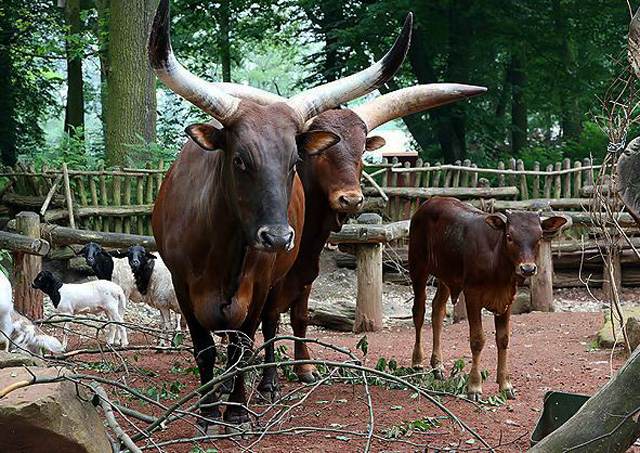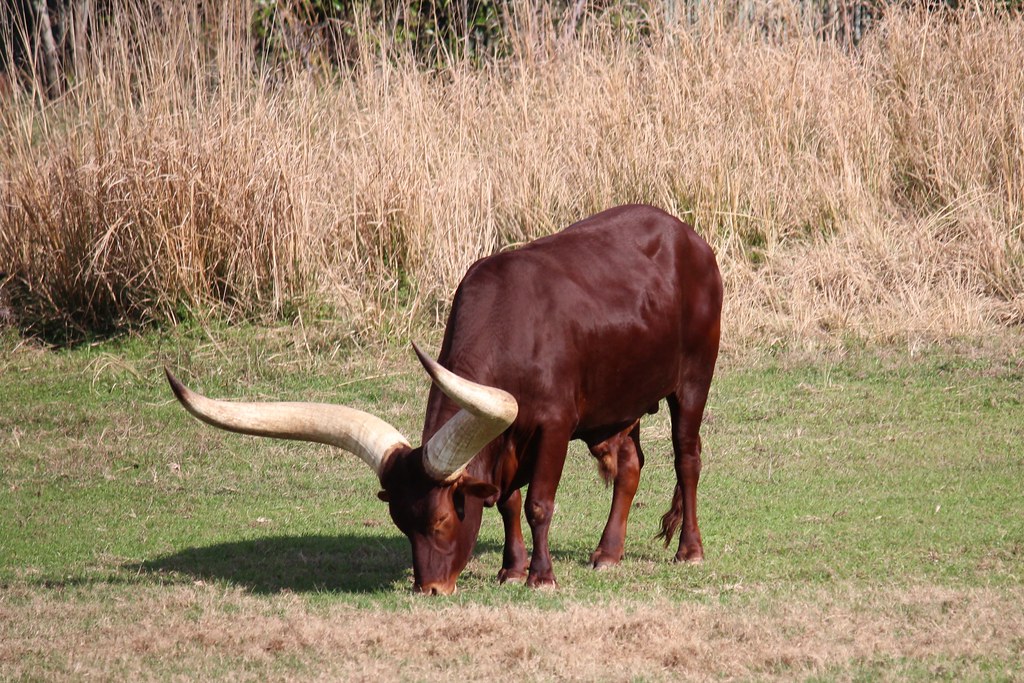Watussi cattle is, like most African breeds, a very hardy landrace that is able to live on poor forage. Of course it is adapted to much higher temperatures than European landraces and have a quite thin coat, but we know that they can low temperatures being kept outside all the year round, and crossbreeding with more cold-adapted breeds and selection will further improve that ability.
 |
| Watussis standing in the snow; the coat is insulating enough that the snow does not melt (forget the colour) |
Despite extensive internet research, I haven't found any data on Watussi size. I think the size of that breed might be heterogeneous, but probably numerous Watussi are larger than Heck cattle, so I'd categorize it as a medium-sized breed in my size categorization scheme. The leg length of Watussi isn't that bad either, quite a lot actually have long and slender legs.
The body is floppy and massive in most Watussis, but this problem should be familiar from other breeds. The zebuine hump should not be all that difficult to breed out, it left no track in Heck cattle. The colour in Watussi is variable, but most have a weird, homogeneously reddish coat. I think this wild type colour plus some unidentified zebuine modifier, since some Watussi clearly display dark mucosa, a mealy mouth and in some cases even sexual dichromatism - sure signs of wild type colour.
 |
| Vestiges of sexual dichromatism in Watussi |
 |
| Aurochs-coloured Watussi cows (lower one: © ribarn on flickr) |
Other members of that breed might have the black allele, and spots are very common - some have the hereford pattern, but the colour-sized pattern is very common in American Watussi, due to the mutual intermixing with Texas Longhorn. In fact, there are many Watussi x Longhorn crosses, and some of them do look good. And since Longhorns are a very hardy breed as well, their ecologic capacity can be nothing but useful. Some Watussis also are quite long-snouted:
Now lets move to their most interesting and obvious phenotypic aspect: the horns. The horn shape is very variable in this breed. Their dimensions are awesome, and since horn size is a quantitative feature that is very difficult to increase just by selection, the use of such a large-horned breed is advantageous in any case. Of course some Watussi have really exaggerated horns, like Schwarzenegger arms, but I wouldn't say that most members of the breed have horns larger than those of (predominantly pleistocene) aurochs. Many of them have rather upright, straight horns or very outwards-facing horns. However, numerous Watussi have the basic "primigenius spiral", just less extreme and more upwards-outwards. Some individuals even have decently inwards-facing or forwards-pointing horns.
Here are some examples of Watussis with really useful horns:
Watussi cattle has not been extensively used in breeding-back yet. But the use of one half Watussi cross cow in the Neandertal Heck cattle lineage has helped greatly to increase the horn size in Heck cattle, most notable in the Wörth Heck herd. The Hungarian Taurus cattle project in the national park also uses Watussi, with some very decent results, like this cross bull ((Heck x Sayaguesa) x (Hungarian Gray x Watussi)):
I think that Watussi would also be very advantageous for the Lippeaue herd to increase the horn size and maybe also to modify the horn curvature.
The Tauros Programme might need that breed as well, to get rid of very small horn dimension contributed by many of the used breeds and to achieve a satisfying aurochs-like horn size.
If a breeding-back program, or any breeder, takes the time to find a Watussi cow that is large and long-legged, does not have too much undesired colour genes and has a long snout, I'd opt for using that cow at any time. I think that German zoos have a number of useful individuals.
So, my today recommendation for breeding-back is: More Watussi, please!


.jpg)









https://www.facebook.com/truenaturefoundation/posts/1472482199631137
ReplyDeleteYep, I know about this, a post on the Uruz Project is about to come. ;-)
DeleteWhat is true of the special watusi adaptations to heat? Some stories circulate on the internet about their horns having large amounts of bloodvessels to cool their body. Is their any truth in it. Does it impede their use in b-back?
ReplyDeleteThe horns of Watussi are a result of artificial selection, not adaption. It is true that horns (of any bovid) are well-vesseled and they are probably more thermoregulatory active than the rest of the body, but seemingly not significantly since it didn't hinder pleistocene aurochs having really large horns.
DeleteIt's true. The Watussi is underrated. I might use some zebus and Watussi for my own back-breeding project.
ReplyDeleteWith what would u cross them?
Delete